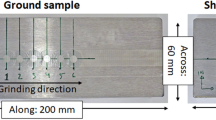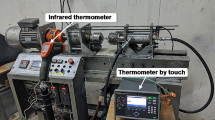Abstract
An ultra-precision magnetic abrasive finishing (UPMAF) process is an efficient mirror finishing technique. This research utilized the ultra-precision magnetic abrasive finishing technique to improve the accuracy of advanced material of Inconel alloy 625 cylindrical bars. The finishing technique employed flexible unbonded magnetic abrasive tools with neodymium permanent magnets (Nd-Fe-B), and components of the finishing procedure were installed with a five-dimensional computer numerical control (CNC) machining center. The surface accuracy and dimensional accuracy of Inconel alloy 625 bars were enhanced by the ultra-precision magnetic abrasive finishing technique with input parameters of workpiece rotational speed, workpiece feed rate, and magnetic abrasive grain size. After characterization with energy dispersive X-ray analysis (EDX), atomic force microscope (AFM), and a thermal imaging camera, we found that this ultra-precision magnetic polishing technology can improve surface roughness Ry of Inconel alloy 625 cylindrical bars from 2010 nm to 200 nm at a rotational speed of 12000 rpm, feed rate of 2000 mm/min, diamond abrasive grain size of 1 μm, and flux density of 300 mT processing of 5 min.
Similar content being viewed by others
References
F. G. L. Pereira, J. M. Lourenço, R. M. D. Nascimento and N. A. Castro, Fracture behavior and fatigue performance of Inconel 625, Materials Research, 21 (2018).
B. Dubiel and J. J. M. Sieniawski, Precipitates in additively manufactured Inconel 625 superalloy, Materials, 12 (2019) 1144.
A. Gunen and E. J. M. Kanca, Microstructure and mechanical properties of borided Inconel 625 superalloy, Matéria (Rio de Janeiro), 22 (2017).
C. Yin, L. Heng, J. S. Kim, M. S. Kim and S. D. Mun, Development of a new ecological magnetic abrasive tool for finishing bio-wire material, Materials, 12 (2019) 714.
A. Parida and K. Maity, Comparison the machinability of Inconel 718, Inconel 625 and Monel 400 in hot turning operation, Engineering Science and Technology, An International Journal, 21 (2018).
B. Słodki, Uild up edge phenomenon and chip forms in Inconel 625 alloy longitudinal turning-case study, Czasopismo Techniczne, 2016 (2016) 103–112.
B. Deepak, R. S. Walia and N. M. Suri, Effect of rotational motion on the flat work piece magnetic abrasive finishing, Int. J. Surf. Eng. Mater. Technol., 2 (2012) 50–54.
P. Jindal, A. Santhanam and U. Schleinkofer, Performance of PVD TiN, TiCN, and TiAlN coated cemented carbide tools in turning, International Journal of Refractory Metals and Hard Materials, 17 (1999) 163–170.
N. Richards and D. Aspinwall, Use of ceramic tools for machining nickel based alloys, International Journal of Machine Tools and Manufacture, 29 (1989) 575–588.
N. J. Park, L. Heng, R. Wang, M. S. Kim and S. D. Mun, Ultra-high-precision machining of microscale-diameter zirconia ceramic bars by means of magnetic abrasive finishing, Applied Mechanics and Materials, Trans. Tech. Publ., 851 (2016) 98–105.
D. K. Singh, V. Jain and V. Raghuram, Experimental investigations into forces acting during a magnetic abrasive finishing process, The International Journal of Advanced Manufacturing Technology, 30 (2006) 652–662.
L. Heng, Y. J. Kim and S. D. Mun, Review of superfinishing by the magnetic abrasive finishing process, High Speed Machining, 3 (2017) 42–55.
S. Greco, K. Gutzeit, H. Hotz, B. Kirsch and J. C. Aurich, Selective laser melting (SLM) of AISI 316L-impact of laser power, layer thickness, and hatch spacing on roughness, density, and microhardness at constant input energy density, The International Journal of Advanced Manufacturing Technology, 108 (2020) 1551–1562.
C. Y. Yap, C. K. Chua, Z. L. Dong, Z. H. Liu, D. Q. Zhang, L. E. Loh and S. L. Sing, Review of selective laser melting: materials and applications, Applied Physics Reviews, 2 (2015) 041101.
G. Strano, L. Hao, R. M. Everson and K. E. Evans, Surface roughness analysis, modelling and prediction in selective laser melting, Journal of Materials Processing Technology, 213 (2013) 589–597.
P. K. Gokuldoss, S. Kolla and J. Eckert, Additive manufacturing processes: selective laser melting, electron beam melting and binder jetting-selection guidelines, Materials (Basel), 10 (2017) 672.
K. Naveen, V. V. Shanbhag, N. Balashanmugam and P. Vinod, Ultra-precision finishing by magnetic abrasive finishing process, Materials Today: Proceedings, 5 (2018) 12426–12436.
J. Wu, Y. Zou and H. Sugiyama, Study on ultra-precision magnetic abrasive finishing process using low frequency alternating magnetic field, Journal of Magnetism and Magnetic Materials, 386 (2015) 50–59.
G. Ghosh, A. Sidpara and P. P. Bandyopadhyay, Review of several precision finishing processes for optics manufacturing, Journal of Micro Manufacturing, 1 (2018) 170–188.
K. Naveen, V. V. Shanbhag, N. Balashanmugam and P. Vinod, Ultra-precision finishing by magnetic abrasive finishing process, Materials Today: Proceedings, 5 (2018) 12426–12436.
Y. Zou, S. Akutsu and T. Sinmura, Development of a new ultra-precision magnetic abrasive finishing process, Journal of the Japan Society for Abrasive Technology, 54 (2010) 97–100.
J. Z. Wu and Y. Zou, Study on an ultra-precision plane magnetic abrasive finishing process by use of alternating magnetic field, Applied Mechanics and Materials, 395–396 (2013) 985–989.
J. Guo, K. H. Au, C. N. Sun, M. H. Goh, C. W. Kum, K. Liu, J. Wei, H. Suzuki and R. Kang, Novel rotating-vibrating magnetic abrasive polishing method for double-layered internal surface finishing, Journal of Materials Processing Technology, 264 (2019) 422–437.
Q. Zhang, R. Tang, K. Yin, X. Luo and L. Zhang, Corrosion behavior of Hastelloy C-276 in supercritical water, Corrosion Science, 51 (2009) 2092–2097.
S. Kosaraju, M. Vijay Kumar and N. Sateesh, Optimization of machining parameter in turning Inconel 625, Materials Today: Proceedings, 5 (2018) 5343–5348.
A. Goyal, A. Pandey and P. Sharma, Investigation of surface roughness for inconel 625 using wire electric discharge machining, IOP Conference Series: Materials Science and Engineering, 377 (2018) 012109.
M. Sagawa, S. Hirosawa, H. Yamamoto, S. Fujimura and Y. Matsuura, Nd-Fe-B permanent magnet materials, Japanese Journal of Applied Physics, 26 (1987) 785.
H. Sepehri-Amin, S. Hirosawa and K. Hono, Chapter 4 — advances in Nd-Fe-B based permanent magnets, E. Brück (Ed.), Handbook of Magnetic Materials, Elsevier (2018) 269–372.
Acknowledgments
This work was financially supported by the National Research Foundation of Korea via a grant funded by the Korean government (Project No: 2020R1F1A1061754).
Author information
Authors and Affiliations
Corresponding author
Additional information
Jung-Tak Bae is currently a Ph.D. student in Jeonbuk National University and his research field is related to 3-D, 5-D CNC machine center, EDM wire cutter and ultra-precision lapping process.
Han Joo Kim is currently a Professor of Convergence Tech. Eng. at Jeonbuk National University. His research interests are automotive parts and composite materials.
Rights and permissions
About this article
Cite this article
Bae, J.T., Kim, H.J. Finishing characteristics of Inconel alloy 625 bars in ultra-precision magnetic abrasive finishing using CNC machine center. J Mech Sci Technol 35, 2851–2859 (2021). https://doi.org/10.1007/s12206-021-0608-y
Received:
Revised:
Accepted:
Published:
Issue Date:
DOI: https://doi.org/10.1007/s12206-021-0608-y




